“Today the three largest mental health sites in the U.S. are jails.”
That stunning quote is from Mind Fixers “a nuanced account of biological psychiatry” by Anne Harrington, per a review this past weekend (May 4-5) in the “Books” section of the Wall Street Journal. Not much has changed since my mother’s mother, my Grandma K, was diagnosed with psychosis in 1949. At that time, the main sites housing mental patients were abusive and neglectful warehouses for the insane.
Mother’s Day and Mental Health Awareness Month
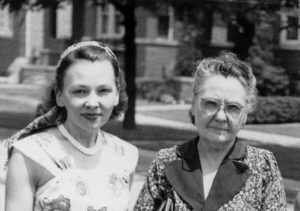
My mom, Lillian, and her mom, Louise Koroschetz, my Grandma K, early 1950s
In May we’re called upon to honor our mothers and to increase our awareness of mental health for ourselves, our families, and others. With this post I hope to do both: honor my mother for the anguished choices she alone, as an only child, could make about her mentally ill mother, and bring the choices she had to make at that time into focus in our own time.
In my book, Redlined, a major thread running through the story of my parents’ lives includes the damaging and dangerous effect my maternal grandmother’s mental illness had on my parents’ marriage and in our family’s lives.
My mother had to decide whether to keep her at home or place her in an institution. It was a Hobson’s choice. Here’s why.
Early signs of psychosis
Grandma K had been demonstrating psychotic behavior for several years before she was officially diagnosed with “psychosis.” In the summer of 1942, just a few months before my parents’ wedding, Grandma K was angry, aggressive, depressed, and delusionary. Mom was so frightened that she began recording her mother’s aberrant behavior in a small spiral notebook.
Murder accusation
Ten months after my parents’ marriage, Mom’s father died of throat cancer. Grandma K claimed that Mom had killed her own father with poison Coke! Despite that absurd accusation, Mom invited her bereft mother to move into the small apartment she and Dad shared.
Twenty-five pages record the madness
Just before my parents’ first child, my older brother, Paul, was born, Grandma again spiraled into such serious mental instability that my mother created a twenty-five page, single-spaced, typed document for a psychiatrist, detailing her mother’s irrational behavior.
Grandma K listened to nonexistent voices that told her what to do. She made a speech to the president, she claimed gleefully, and he’d laughed. She found evil intent behind every innocuous mishap. She verbally and physically attacked my mother and father.
Shock treatments: Electro-convulsive therapy
The psychiatrist recommended ECT, electroconvulsive therapy. My grandmother had several treatments. After several days of memory loss and confusion, she seemed better. Three days before my brother was born, Mom wrote in her diary that the psychiatrist had “performed a miracle on Mama, and we should be grateful.”
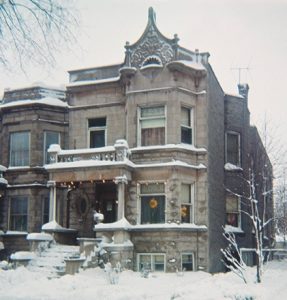
Our two-flat on Washington. We moved into it in June 1949.
A diagnosis of psychosis
But the miracle didn’t last. About three years later, just before my birth in 1949, Grandma again fell into serious depression, refusing to get out of bed. Mom called an ambulance to take her mother to Cook County Psychopathic Hospital.
After examining and evaluating Grandma K, two doctors testified in Cook County Court that “Louise Koroschetez is mentally ill and is a fit person to be sent to a state hospital for the mentally ill.”
Instead, Mom brought her mother home to live with us in our newly purchased two-flat on Washington Boulevard in West Garfield Park.
Why had she made this choice when her mother was so seriously ill and posed a danger to her family?
Bedlam 1946
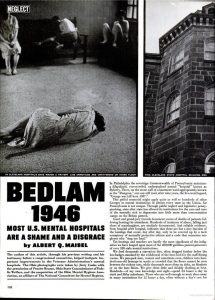 The answer must lie in what the public had recently learned about the hideous conditions in mental health institutions at that time. A Life Magazine article, “Bedlam 1946,” was subtitled, “Most U.S. Mental Hospitals are a shame and a disgrace.” Photos more than confirmed that statement, along with revelations like this:
The answer must lie in what the public had recently learned about the hideous conditions in mental health institutions at that time. A Life Magazine article, “Bedlam 1946,” was subtitled, “Most U.S. Mental Hospitals are a shame and a disgrace.” Photos more than confirmed that statement, along with revelations like this:
” . . . Thousands spend their days-often for weeks at a stretch-locked in devices euphemistically called ‘restraints’ : thick leather handcuffs, great canvas camisoles, ‘muffs,’ ‘mitts,’ wristlets, locks and straps and restraining sheets. Hundreds are confined in ‘lodges’ – bare, bed-less rooms reeking with filth and feces . . . .”
In 1949, the same year of the diagnosis and recommendation to institutionalize my grandmother, the movie The Snake Pit was nominated for an Oscar for Best Picture. It depicted staff at mental institutions as cruel an incompetent.
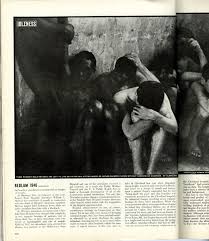 These images and themes were undoubtedly in my mother’s mind as she had to decide what to do with Grandma K. She chose to bring Grandma into our home, where she helped with day-to-day chores, but also created an atmosphere of hostility and danger.
These images and themes were undoubtedly in my mother’s mind as she had to decide what to do with Grandma K. She chose to bring Grandma into our home, where she helped with day-to-day chores, but also created an atmosphere of hostility and danger.
Mental illness affects the whole family
I’m convinced that my grandmother’s disruptive presence in our home was a major cause of the unraveling of my parents’ marriage. Through Dad’s diary entries, I learn of the many times, he saved Mom from injury, squeezing between them when Grandma had her fist raised to hit Mom or the worst–when Grandma tried to push Mom down our back stairs.
Continuous closing of state hospitals
I started this post with a quote from the new book, Mind Fixers by Anne Harrington, stating, “Today the three largest mental health sites in the U.S. are jails.”
Harrington also writes that “the cost of maintaining state hospitals compelled their downsizing in the 1930s.” That was twelve years before Mom made her first record of Grandma K’s clearly delusional experience. So fewer and fewer institutions were available for the mentally ill, and those that did exist were often almost medieval in their cruelty.
Once antipsychotic drugs appeared on the scene, despite the fact that many patients stopped taking them due to side effects, “deinstitutionalization accelerated …and numerous state hospitals had closed by the 200s. Alone and adrift in society, many patients wound up homeless or in prison.”***
We have an exploding prison population (the highest rate in the world) and an explosion of homelessness. Up to 50,000 to 60,000 people can be found to be homeless any given night in Los Angeles. New York has about 78,000 homeless.* Homeless “living in the streets, encampments or other open places was more than 194,000 nationwide.”**
During Mental Health Awareness Month, let’s be aware of the cost to society of not caring for the mentally ill with decent institutions. How would a year in a mental institution compare to that of a year in jail, with far better outcomes in the long run? What’s the cost of the homeless scattered over sidewalks, with unsanitary risks to themselves and to society?
A shout-out to my mom for trying to do her best for her mom, in an era of few good choices.
*Statistics from U.S. Department of Housing and Urban Development
**Geoff Mulvihill, Associated Press, Dec. 17th 2038
***“There has to be a better way.”
Redlined tells a first-hand story about a West Side Chicago family’s personal struggles and dreams intersecting with the racial upheavals of the 1960s.
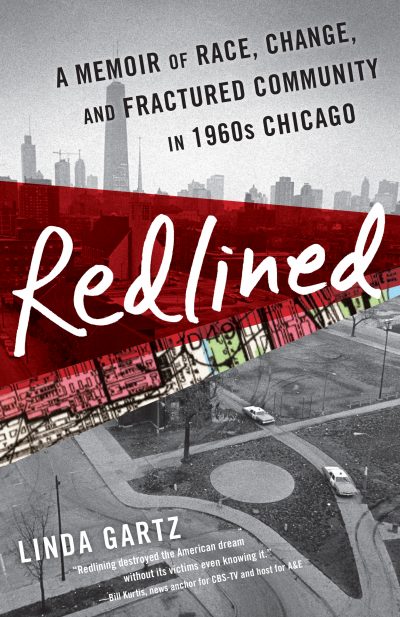

Hi Linda, I read with interest your riveting article about the mental illness in your grandmother, and the horrible state of mental hospitals. I also had mental illness in my family and it does disrupt lives. I have purchased Redlining, and am studying it, for format right now. Your book is beautiful. I got my contract to review from Brooke, and may publish in a year or 2. I wondered if you could tell me your experience with SWP? And with promotion and sales in general. That would be most helpful. thank you. And Happy Mothers day!